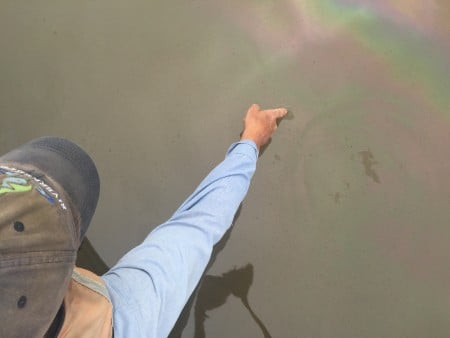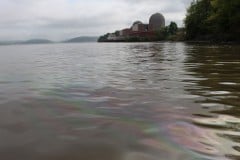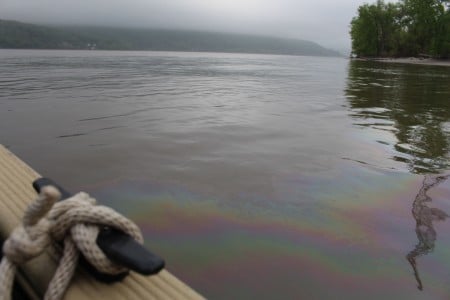Latest Indian Point accident is proof positive that the plant must be closed

View more images on our Flickr site
Indian Point 3 is exempt from the fire-protection standards required of other nuclear power plants
For Immediate Release: May 10, 2015
Contact: Cliff Weathers, 914-478-4501, Ext 239
NOTE TO EDITORS: A photograph of the oil sheen near Indian Point is attached. More will be made available upon request.
BUCHANAN, NY – The May 9 transformer fire at the Indian Point nuclear power plant – its third in the past eight years – appears to have resulted in an oil spill that could impact the health of the Hudson River and demonstrates why Indian Point must close.
 On Mother’s Day morning, Riverkeeper patrolled the Hudson off Indian Point after the previous evening’s transformer fire, looking for possible discharges of transformer oil and/or of firefighting foam into the Hudson. Riverkeeper patrolled to the north and south of the plant and across the river on the Western (Rockland) shoreline. The patrol boat crew found areas of sheen at all locations except, thankfully, immediately at the Peekskill waterfront.
On Mother’s Day morning, Riverkeeper patrolled the Hudson off Indian Point after the previous evening’s transformer fire, looking for possible discharges of transformer oil and/or of firefighting foam into the Hudson. Riverkeeper patrolled to the north and south of the plant and across the river on the Western (Rockland) shoreline. The patrol boat crew found areas of sheen at all locations except, thankfully, immediately at the Peekskill waterfront.
 The oil sheen and notable odor were heaviest close to the Indian Point power plant. Riverkeeper also noticed that a containment boom at the power plant, designed to hold back a leak, had a gap in it and notified the DEC. A second boom was being deployed at 9:10 a.m. on Sunday.
The oil sheen and notable odor were heaviest close to the Indian Point power plant. Riverkeeper also noticed that a containment boom at the power plant, designed to hold back a leak, had a gap in it and notified the DEC. A second boom was being deployed at 9:10 a.m. on Sunday.
The fire started in the switch yard of the Indian Point 3 reactor and was difficult to put out. Firefighters had to use a fire suppressant foam to get it under control. New York Gov. Andrew Cuomo, who inspected the aftermath of the fire on Saturday, expressed concerns regarding the volume of foam and oil released, saying that it could enter the river through storm drains.
“This is a problem to be taken with the utmost seriousness,” said Riverkeeper President Paul Gallay. “Indian Point has a long, disturbing history of operational and environmental problems. The plant’s aging infrastructure has caught up to it and we must see that it is closed or these problems will only worsen with potentially catastrophic results.”
The latest accident comes only days after an unplanned shutdown at the plant due to a steam leak.
A 2011 transformer explosion leaked large quantities of polychlorinated biphenyls (PCBs) from the oil into the groundwater. Questions remain as to Indian Point’s compliance with consent order requirements following the 2011 explosion. Riverkeeper is calling on the State of New York to take aggressive enforcement action in the wake this most recent event. In addition to plant closure, the organization wants the state to investigate this most recent accident and Entergy’s possible non-compliance of the enforcement order following the 2011 transformer explosion.
Fire safety at Indian Point has been an ongoing concern. The Indian Point 3 reactor has only 24 minutes of fire safety insulation instead of the three-hour fire barrier that the Nuclear Regulatory Commission (NRC) requires of other nuclear plants. Litigation against the NRC for refusing to require Entergy to retrofit Indian Point with adequate fire insulation has been going on since 2007. The case will be heard again in the coming months.
“The history of fire safety at Indian Point is one of mistakes, illegality, and failure by both Entergy and the NRC,” said Gallay. “The plant should not be operated under its current fire safety regime. The plant is not cheaper, it’s not safe, and it’s not necessary. It’s time to close Indian Point and move on.”
###
Riverkeeper is a member-supported watchdog organization dedicated to defending the Hudson River and its tributaries and protecting the drinking water supply of nine million New York City and Hudson Valley residents.

Sheen observed off Verplanck Point, May 10, 2015

